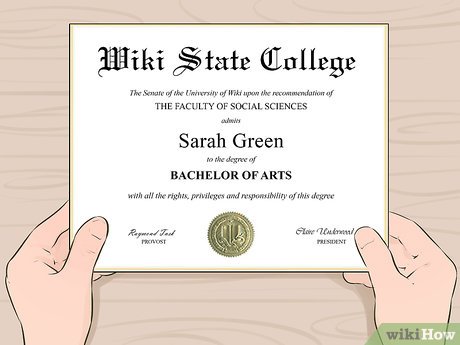How to Become an Academic
An academic is a person who holds an advanced degree, such as a PhD, and often works as a lecturer or researcher at a university or scholarly institution.http://www.academiccareer.manchester.ac.uk/about/becomeanacademic/ However, you may...
Part 1 of 3:
Considering an Academic Career
-
 How to Become an Academic Picture 1 Learn about being an academic. Someone who pursues an academic career often works at a university or research institution in a specific discipline such as biology, history, or political science. During their graduate program, academics generally spend 1 or more years working as teaching assistants at a college or university. These are paid positions that feature tuition and fee waivers in addition to a paycheck for teaching 1-2 classes each academic term. You'll also need to conduct research and complete projects, such as a dissertation. Once you graduate, you'll need to competitively seek employment at a college or university, where you'll continue your research, writing, and teaching. If you like studying, writing essays, and teaching, academia might be a good choice for you.[3]
How to Become an Academic Picture 1 Learn about being an academic. Someone who pursues an academic career often works at a university or research institution in a specific discipline such as biology, history, or political science. During their graduate program, academics generally spend 1 or more years working as teaching assistants at a college or university. These are paid positions that feature tuition and fee waivers in addition to a paycheck for teaching 1-2 classes each academic term. You'll also need to conduct research and complete projects, such as a dissertation. Once you graduate, you'll need to competitively seek employment at a college or university, where you'll continue your research, writing, and teaching. If you like studying, writing essays, and teaching, academia might be a good choice for you.[3]- Investigate your job options. The U.S. Department of Labor analyzes job opportunities in 800 fields in its Occupational Outlook Handbook that is published annually and on its website bls.gov. Enter 'Occupational Outlook Handbook' in the bls.gov search window. It's increasingly difficult to find permanent or tenured jobs in academia.[4]
- Researching, writing, taking part in academic conferences, and teaching something about which you are passionate can be incredibly rewarding and make academia seem less like a 'job.'
EXPERT TIP'A typical career in academia is focused on teaching and research within a university setting.'
Christopher Taylor is an Adjunct Assistant Professor of English at Austin Community College in Texas. He received his PhD in English Literature and Medieval Studies from the University of Texas at Austin in 2014. How to Become an Academic Picture 2
How to Become an Academic Picture 2 Christopher Taylor, PhD
Adjunct Assistant Professor of English How to Become an Academic Picture 3 Christopher Taylor, PhD
How to Become an Academic Picture 3 Christopher Taylor, PhD
Adjunct Assistant Professor of English -
 How to Become an Academic Picture 4 Talk to an academic. If you think you want to be an academic, consider meeting someone who is already one in the your desired field or discipline. They can tell you about the realities of academia, answer questions you have, give you tips for getting started, and guide your goals for the future.[5]
How to Become an Academic Picture 4 Talk to an academic. If you think you want to be an academic, consider meeting someone who is already one in the your desired field or discipline. They can tell you about the realities of academia, answer questions you have, give you tips for getting started, and guide your goals for the future.[5]- In the U.S., college and university professors have regular office hours each week as part of their employment. Members of the public can schedule a half hour to an hour appointment to ask questions about entering the profession. If a senior professor is too busy to have time, usually a younger professor will be suggested who is up to date on the most recent trends concerning entering the field and transitioning from graduate school to employment.
- Inquire how they got into their academic career. Ask about their education and/ or any professional or practical experience they had.
-
 How to Become an Academic Picture 5 Think about your personality. An academic career can be very demanding. You'll need to constantly be learning about new concepts and sharing that knowledge in a variety of modes, such as journal articles, books, and the classes you teach. You'll also need to compete for positions. In addition, working with a university faculty can require navigating delicate personal and political situations. You will need to set aside your own emotions and biases to provide equal treatment of all. You might want to ask yourself some of the following questions:
How to Become an Academic Picture 5 Think about your personality. An academic career can be very demanding. You'll need to constantly be learning about new concepts and sharing that knowledge in a variety of modes, such as journal articles, books, and the classes you teach. You'll also need to compete for positions. In addition, working with a university faculty can require navigating delicate personal and political situations. You will need to set aside your own emotions and biases to provide equal treatment of all. You might want to ask yourself some of the following questions:- How deep is my commitment to this field?
- Am I willing to potentially move often and continuously pursue jobs?
- Am I willing to start part-time as an adjunct faculty member?
- Am I able to work in an unstructured environment and self-start projects?
- Can I create and pursue my own research topics?
- Am I willing to participate on a campus committee that has meetings?
- Do I want to be a mentor to students?
- Can I handle the competitive nature of this career?[6]
-
 How to Become an Academic Picture 6 Consider your career and salary goals. Academics often choose their career because it's their passion. However, the jobs you get may depend on what's available at the time. Additionally, salary can vary wildly, as high paying positions are limited. People with the same credentials can make vastly different salaries.
How to Become an Academic Picture 6 Consider your career and salary goals. Academics often choose their career because it's their passion. However, the jobs you get may depend on what's available at the time. Additionally, salary can vary wildly, as high paying positions are limited. People with the same credentials can make vastly different salaries.- Ask yourself if you'd like to teach and work with students.
- Consider if you're only interested in working with other academics, such as in a think tank.[7]
- Look up salary amounts in your area. Consider if you can adapt your lifestyle if necessary. For example, a full professor will make considerably more than an adjunct professor or lecturer.[8] The amount can also differ according to your experience and job location.[9]
- Think about the other skills you can use to add to your income, and if you'd be willing to take on other work. For example, community college, college, and university faculty in the U.S. sometimes make a significant portion of their income through authoring or co-authoring textbooks used in their fields.[10]
Part 2 of 3:
Getting Education and Experience
-
 How to Become an Academic Picture 7 Finish your bachelor's degree. You have to finish your bachelor's degree to pursue a PhD, which is generally the education requirement for a career in academia.[11] Take classes in the discipline that you'd like to be an academic to give yourself an advantage of getting into graduate programs and make attaining your PhD somewhat easier.
How to Become an Academic Picture 7 Finish your bachelor's degree. You have to finish your bachelor's degree to pursue a PhD, which is generally the education requirement for a career in academia.[11] Take classes in the discipline that you'd like to be an academic to give yourself an advantage of getting into graduate programs and make attaining your PhD somewhat easier.- Save all of your undergraduate and graduate essays, since you may need them when you apply to graduate programs to show as an example of your work. Additionally, they may inspire your future research.
- Consider majoring in your preferred academic discipline or one closely related to it. For example, if you want to be an animal behaviorist, you could major in ethology or comparative psychology.[12] If you want to be a historian, you could consider anthropology or philosophy.
- Take courses that complement your preferred field of specialization. For example, if want to be an archaeologist, consider classes in history and anthropology.
-
 How to Become an Academic Picture 8 Substitute teach to gain experience, if you aren't sure about academia. With a bachelor's degree in the U.S., you can substitute teach almost anywhere, as long as you have a clean background check. This will allow you to try out the teaching profession for a year with pay to see if you like being in front of the classroom. This also allows you to apply for a graduate teaching assistantship with teaching experience.
How to Become an Academic Picture 8 Substitute teach to gain experience, if you aren't sure about academia. With a bachelor's degree in the U.S., you can substitute teach almost anywhere, as long as you have a clean background check. This will allow you to try out the teaching profession for a year with pay to see if you like being in front of the classroom. This also allows you to apply for a graduate teaching assistantship with teaching experience.- If you already know you want to be an academic, you may want to immediately enter an advanced degree program. However, substituting still provides valuable experience to help further your prospects.
-
 How to Become an Academic Picture 9 Obtain an advanced degree. After your bachelor's degree, the next step will be your master's degree. Depending on the field, you may choose a Master of Arts, Master of Science, or Master of Fine Arts. Most academic positions require a Doctor of Philosophy (PhD) once you've finished your bachelor's degree or master's degree.[13] Having the right degrees ensures to you—and potential employers-- that you have mastered the required information to pursue a career in academia.
How to Become an Academic Picture 9 Obtain an advanced degree. After your bachelor's degree, the next step will be your master's degree. Depending on the field, you may choose a Master of Arts, Master of Science, or Master of Fine Arts. Most academic positions require a Doctor of Philosophy (PhD) once you've finished your bachelor's degree or master's degree.[13] Having the right degrees ensures to you—and potential employers-- that you have mastered the required information to pursue a career in academia.- For example, in the U.S., a newly hired assistant professor is frequently assigned to teach courses in the dissertation field, since the new PhD has been vetted already in that topic by a faculty committee in his or her graduate school program.
-
 How to Become an Academic Picture 10 Pursue your PhD. Since most academics teach and do research at universities or colleges, you will need a graduate degree. Most institutions require a PhD, though some institutions and disciplines may only require an MA or MS, or even professional experience.[14]
How to Become an Academic Picture 10 Pursue your PhD. Since most academics teach and do research at universities or colleges, you will need a graduate degree. Most institutions require a PhD, though some institutions and disciplines may only require an MA or MS, or even professional experience.[14]- Some programs allow you to earn both your MA and PhD at the same time, though you'll need to complete the coursework for your MA before pursuing the PhD coursework.
- Learn about different programs in your specific discipline. Different universities have different disciplines and fields in which they specialize.[15] For example, if you want to be an animal behaviorist, you might want to find specific programs in this field or related fields. Likewise, if you want to be a historian of Europe, you'd want to figure out the best programs for that instead of for American history.[16]
- Make sure your degree granting institution is accredited, which assures that the quality of your education meets acceptable levels. The US Department of Educations provides a list of accredited universities.[17]
-
 How to Become an Academic Picture 11 Conduct research. Most academics conduct original research and then publish it. You'll prepare a dissertation as part of your graduate program. Once you start working as an academic, you'll write articles, books, and other media. Research or creative production is often the bread and butter of any academic.[18]
How to Become an Academic Picture 11 Conduct research. Most academics conduct original research and then publish it. You'll prepare a dissertation as part of your graduate program. Once you start working as an academic, you'll write articles, books, and other media. Research or creative production is often the bread and butter of any academic.[18]- Be aware that the point of 'scholarship' is to expand current knowledge of your particular field.
- Make sure your research is original and that no one has used your specific topic and/or method of analysis before you begin. This will require that you master the scholarly literature related to your field.
- Choose an area that hasn't been explored in depth.[19]
- Make sure to get any permissions or clearances you need to do your research, especially if it requires using human or animal subjects.
- Take copious and detailed notes, as this will help you write up and publish your research. You should maintain digital files with notes that include your citations. Then, when you are faced with seminar papers, theses, and dissertation writing, you can cull through these digital files rather than having to start from scratch.
-
 How to Become an Academic Picture 12 Publish your findings when they're ready. One of the primary components of being an academic is publishing your research findings.[20] In fact, sometimes one will hear the phrase 'publish or perish.' Start by submitting to journals and conferences. Aim to publish your research at a rate commensurate to your field.
How to Become an Academic Picture 12 Publish your findings when they're ready. One of the primary components of being an academic is publishing your research findings.[20] In fact, sometimes one will hear the phrase 'publish or perish.' Start by submitting to journals and conferences. Aim to publish your research at a rate commensurate to your field.- Your thesis is a good starting topic for your dissertation, and your dissertation is a good starting presentation for your first book.
- Wait to publish your thesis or dissertation until after it's been accepted. A master's thesis and a PhD dissertation are commonly only acceptable in the U.S. if the material has not already been published--even by the same author.
- Begin publishing your research as soon as it is ready, including if you are still in graduate school unless your department or your graduate school only accepts unpublished materials for the thesis/dissertation.
- Ask colleagues and friends about what general expectations for publication within your field are. If you work at a university, there may be guidelines on publication expectations.
- Aim to publish with the most prestigious academic presses or peer-reviewed journals in your field as possible. This can help you gain exposure and may help complete your portfolio for tenure. Note that print and online journals have 'author guidelines' that you need to check concerning how the specific journal requires submissions to be made.
-
 How to Become an Academic Picture 13 Teach courses in your field. Many academics who work at universities conduct research and teach students. Getting teaching experience in your specific and possibly related fields can not only make you attractive to potential employers, but also help you master your field and round out your curriculum vitae.[21]
How to Become an Academic Picture 13 Teach courses in your field. Many academics who work at universities conduct research and teach students. Getting teaching experience in your specific and possibly related fields can not only make you attractive to potential employers, but also help you master your field and round out your curriculum vitae.[21]- Cultural centers, retirement communities, cruise lines, recreational centers and other unexpected places will frequently host academic speakers who are still building a tenure portfolio. Some pay; some accept volunteers only. Keep a copy of each publicity material issued, since you will want to include those in a section on 'Public Presentations in your tenure portfolio.
- See if your university requires being a teaching assistant (TA) as a part of your graduate studies. If your campus has a shortage of teaching assistants, consider volunteering to be a TA in a different field than yours to show your ability to be flexible as an academic. For example, if you work on American history, offer to TA a course on African history. This may help you make connections with your own work as well.
- Ask if you can teach independent or online courses in your field.
- Volunteer to teach courses that may be less popular. The more diversified your teaching experience is, the more attractive you may be to potential employers. Junior faculty are frequently hired to teach the courses senior faculty do not wish to teach. Then over the years, the junior faculty gain the opportunities to list their favorite topics in the curriculum. This develops as colleagues become acquainted and gain trust.
-
 How to Become an Academic Picture 14 Obtain practical experience. Depending on your chosen discipline, consider getting an internship or job that will enhance your coursework with practical experience. Ask if your university or college can help you find internships or jobs that complement your studies.
How to Become an Academic Picture 14 Obtain practical experience. Depending on your chosen discipline, consider getting an internship or job that will enhance your coursework with practical experience. Ask if your university or college can help you find internships or jobs that complement your studies.- Be aware that many graduate programs and employers, particularly in health fields or the sciences, may require internships or practical experience to graduate or start a job.[22]
- Graduate students in the arts most often have the privilege of reserving campus performance space for free. If your campus has an intellectual property attorney, get a copy of a release for performers to sign that allows you to digitize excepts of the performance for your tenure portfolio--and make certain you save copies of the program/publicity materials to document your efforts. If the campus newspaper or community newspaper publishes review, you should retain a copy of that, also, to document your success
- Consider doing an internship complementary to your field. For example, it may be difficult to find an internship as a historian or archaeologist. But you could intern in a library or archives, which would give you experience in conducting research. Explore what is available to you in 'ethnography,' also.
- Get different types of experience to give you sense of what work you could do and what kind of work suits you best. For example, you may want to work for your university astronomy lab during the school year and pursue an internship at a local planetarium in the summer.
- Many internships and residencies, like universities, are also accredited. The US Department of Education also offers a list of these programs.[23]
-
 How to Become an Academic Picture 15 Apply for funding. Whether you are a student or have finished your graduate education, apply for grants and fellowships from your university and outside institutions. Winning grants and fellowships can not only help pay for your research but also attract other organizations to fund you .
How to Become an Academic Picture 15 Apply for funding. Whether you are a student or have finished your graduate education, apply for grants and fellowships from your university and outside institutions. Winning grants and fellowships can not only help pay for your research but also attract other organizations to fund you .- Look for grant and fellowship opportunities at different universities and colleges, research institutions, government agencies, or independent groups. See Chronicle of Philanthropy and its annual register of grants offered. For example, if you are a physicist, see what funding opportunities your university, the National Science Foundation, and the European Physical Society offer.[24] You want to compete for the most prestigious grants as well as smaller ones.
- Be aware that some institutions will require that you be a member in order to apply for funding.
-
 How to Become an Academic Picture 16 Stay on top of current research. Inform yourself about current research/performance in your discipline and specific field, as well as any related fields. You can do this by attending conferences and seminars, reading journals, and networking with colleagues. This knowledge may help you more effectively do your job and can also make you attractive to potential employers.[25]
How to Become an Academic Picture 16 Stay on top of current research. Inform yourself about current research/performance in your discipline and specific field, as well as any related fields. You can do this by attending conferences and seminars, reading journals, and networking with colleagues. This knowledge may help you more effectively do your job and can also make you attractive to potential employers.[25]- Read journals from your specifics areas of expertise and those related to it. For example, if you work on the history of cultural heritage, you might want to read publications by historians, anthropologists, ethnographers, and archaeologists. Legal journals may also be of use.
- Subscribe to journals related to your specific fields, read online journals, and familiarize yourself with library collections of periodicals in your field. This can help you stay most current on research through articles and reviews. You may also find job listings in these journals.
- Go to conferences for your specific discipline and field. For example, if you are a quantum physicist, you could attend the American Physical Society's annual conference as well as that of International Quantum Structure Association.[26] Some of these professional associations also offer academic placement services. For example, College Composition and Communications assists graduate students in obtaining placement in non-fiction writing and in speech making.
- Be aware that staying on top of current research can also help your teaching profile. As an academic, you will be expected to have things to say, and keeping up with research and performance in your discipline gives you things to talk about person to person with colleagues and in the classroom when you are fielding student questions.
Part 3 of 3:
Finding Job Opportunities
-
 How to Become an Academic Picture 17 Start your job search early. Ideally, you will learn about shortage areas in your field by reading job postings. Being aware of shortages allows you to add a few graduate courses in those shortage areas, so that you can provide 'coverage' for those topics when you are hired into a faculty.[27] If you wait until you finish your PhD to find a job, your skills might not match the demand, and you may have trouble securing even a term position as an adjunct.[28]
How to Become an Academic Picture 17 Start your job search early. Ideally, you will learn about shortage areas in your field by reading job postings. Being aware of shortages allows you to add a few graduate courses in those shortage areas, so that you can provide 'coverage' for those topics when you are hired into a faculty.[27] If you wait until you finish your PhD to find a job, your skills might not match the demand, and you may have trouble securing even a term position as an adjunct.[28] -
 How to Become an Academic Picture 18 Reference the job posting when you apply. Always tie something in your background to the specific requirements listed in the job posting. Make your application relevant to the needs of the institution to which you are applying.
How to Become an Academic Picture 18 Reference the job posting when you apply. Always tie something in your background to the specific requirements listed in the job posting. Make your application relevant to the needs of the institution to which you are applying.- Start researching universities, agencies, institutions, and organizations with which you may be interested in working when you enter graduate school. Discuss with your graduate faculty what research problems your field is trying to solve, and figure out whether any of those research problems interests you for your thesis/dissertation. Cross check that with job offerings.
- Ask your doctoral advisor, professors, colleagues, friends, and especially the student placement office for advice on where, when, and how to apply for academic jobs.[29]
-
 How to Become an Academic Picture 19 Submit job applications. Most academics work at places like universities and research institutions. Because competition for academic positions in many fields is strong, apply to as many positions as you can in your field or related fields.
How to Become an Academic Picture 19 Submit job applications. Most academics work at places like universities and research institutions. Because competition for academic positions in many fields is strong, apply to as many positions as you can in your field or related fields.- If you have met with any faculty from the posting department, mention that you are applying because of the good impression the department made at the specific conference, how, and why.
- Prepare yourself for rejection. Competition for academic jobs can be very high, and it's very likely you'll have several rejections. Remember that the decision is not personal, but that you're likely in a pool of other very qualified candidates.[30]
- Search the websites or publications of professional academic associations every day. New jobs may appear daily. Academic positions are generally posted 6 to 9 months before the position is to begin.
- Check online listserves specific to your discipline or field.
- Talk to your advisor, professors, or colleagues if they're aware of any job openings. They will generally refer you to published sources that you then need to examine frequently. Once a listing produces hundreds of responses, the posting will generally be taken down, so if you are not watching for postings, you probably will miss some.
- Submit material requested by the position ad. This often includes a cover letter, CV, writing samples, and proof of ability to obtain funding, if the department position is not funded by the school.
-
 How to Become an Academic Picture 20 Consider professional positions. You may prefer a professional position with a business rather than a job at a university or may not have had any luck on the academic market. There are a multitude of options for academics at places like think tanks, government agencies, or museums.[31]
How to Become an Academic Picture 20 Consider professional positions. You may prefer a professional position with a business rather than a job at a university or may not have had any luck on the academic market. There are a multitude of options for academics at places like think tanks, government agencies, or museums.[31]- Remember that you can also try substitute teaching while you seek other positions.
- Look for professional positions in academic publications, newspapers, professional recruiting sites, or by asking headhunters.
- Submit letters of interest and ask about career opportunities at places that interest you. See if you can set up an informational interview.
-
 How to Become an Academic Picture 21 Network with other academics. Meeting and talking with academic colleagues or professionals from your field or related disciplines can expand your ability to find a job as well as increase your knowledge. Go to conferences, establish a local seminar, and join professional organizations to network with fellow academics.
How to Become an Academic Picture 21 Network with other academics. Meeting and talking with academic colleagues or professionals from your field or related disciplines can expand your ability to find a job as well as increase your knowledge. Go to conferences, establish a local seminar, and join professional organizations to network with fellow academics.- Join organizations in your specific discipline and field. For example, if you are a historian of modern Germany you might want to join the American Historical Association and the German Studies Association.
- Go to conferences. Make sure to attend panels related to your work and any social events offered. These can help you meet new people who share your interests. Academics want to be known in their fields. Being an academic is a social role in addition to a continuing study function
- Set up regular meetings or seminar meetings for colleagues in your field and discipline or related disciplines in your local area. Keep the publicity materials for inclusion in your tenure portfolio. These portfolios can be inches thick or feet thick depending on the academic discipline. Circulate feedback forms and retain the most positive ones for inclusion in your tenure portfolio.
4 ★ | 1 Vote
You should read it
- How to Conduct Academic Research
- How to Publish a Research Paper
- 5 best search tools for academic research
- How to Cite a Blog in APA
- How to Appeal Academic Probation
- How to Become a Gender Studies Professor
- How to Do Qualitative Research
- How to Promote Your Academic Career
- Professional Essay Writers Online: Find Experts Who Will Help You With All Kinds of Academic Tasks
- How to Do a Case Study
- How to Finish College Fast
- How to Research a Topic


























 How to Appeal Academic Probation
How to Appeal Academic Probation 5 best search tools for academic research
5 best search tools for academic research Professional Essay Writers Online: Find Experts Who Will Help You With All Kinds of Academic Tasks
Professional Essay Writers Online: Find Experts Who Will Help You With All Kinds of Academic Tasks How to Promote Your Academic Career
How to Promote Your Academic Career How to Do a GIS (Geographic Information Systems) Academic Project
How to Do a GIS (Geographic Information Systems) Academic Project How to Do a Case Study
How to Do a Case Study